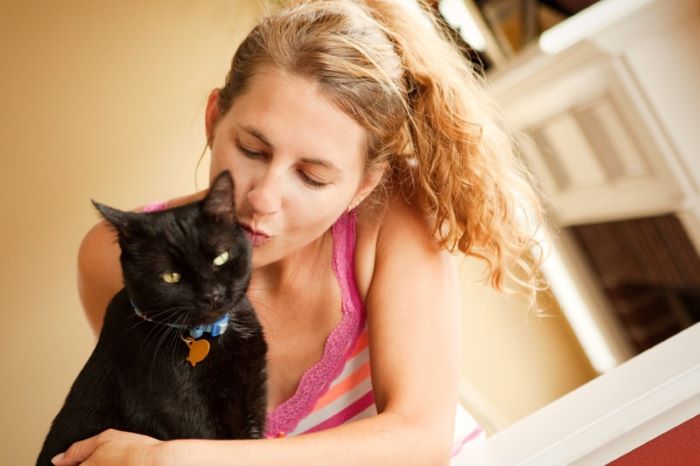By nature, cats are solitary creatures, although some cats are able to live quite happily in groups. Bringing a new cat into your home may change his whole outlook on the people and other animals around him.
If you make introductions carefully and sensitively, your cat will grow into a confident, friendly animal that can cope with a variety of social situations.
Start Early
Socialization should start in kittenhood. Give your kitten plenty of opportunities to meet new people, cats, and dogs, and make it a fun and rewarding experience. Introduce him to friends, neighbors, and the vet at an early stage; keep initial encounters brief and reward your kitten with treats for good behavior.
A cat that is not exposed to new situations as a kitten may grow up to be timid and fearful and will likely react badly to being touched or approached by strangers or other animals.
It is important that your kitten gets used to being handled and that it is given plenty of play designed to hone his predatory skills, but let him sleep when he wants to.
Socializing an Adult Cat

If you are adopting an adult cat, it will take longer than a kitten to adapt to new people and surroundings. Changes in routine are upsetting for an older cat. Try to get as much information as possible from the previous owner or animal shelter about the cat’s habits, personality, and favorite food and toys.
Familiar objects can help him to settle in, so try to bring some of his old bedding or toys to make him feel more secure. Provide him with a refuge, such as a carrier or box, to which he can retreat and feel safe.
An older cat may initially be wary of contact with his new owners and may resist being touched. Let him explore his surroundings in his own time. Talk to him in a low, soothing tone so that he gets used to your presence and the sound of your voice.
One of the chief problems with poorly socialized cats is that they play too rough, biting and scratching to get what they want. If that is the case, simply stop playing with him, say “no” in a firm voice, and give him a toy instead.
Give plenty of praise when your cat is playing nicely with you, but also praise him when he takes his aggression out on a toy. That way, he will learn that he can play hard with toys but not with you.
Instead of forcing your cat to meet strangers, let him approach them when he is ready; once he realizes that nothing bad is going to happen, he will become more confident and trusting. If you have to leave your cat to be looked after by friends or neighbors, get him used to the new people before asking them to come to your home.
Introducing a New Baby
If your cat has always been the center of attention, he may become jealous of the competition for affection when a new baby arrives. Some careful preparation can help prevent this.
Before the birth, allow your cat to examine the baby’s room and equipment, but make it clear that he is not allowed in on his own and that the crib, baby basket, and stroller are off limits. If your cat has any behavioral problems that you need to address, now is the time to do it, since they may get worse when the baby arrives.
When you bring the baby home for the first time, allow your cat to sit next to the baby and give him treats for good behavior so that he associates the baby with a positive experience. Never leave the baby and cat alone together.
Close the door to the room where your baby is sleeping. Try to keep your cat’s routine as normal as possible and make sure he gets his share of attention from someone in the family.
Other Cats in the Home
Your cat sees your home as his territory and bringing another adult cat into the house may be seen as a threat. A new kitten, however, is more likely to be tolerated by the resident cat. Keep a lookout for bullying and jealousy on the part of the adult cat.
If it looks like the older cat is picking on the kitten, keep the two apart until the newcomer is more able to look after itself. Remember, this is the older cat’s territory and his natural instinct is to protect it from interlopers, however small.
Make sure that the older cat gets his share of love and attention, and reward him with treats for good behavior. The two will gradually get used to each other and develop a companionable truce.
Meeting Other Pets
Whether you are introducing a new cat to a dog or a new dog to a cat, similar methods of socializing them can be used. When you first bring your new cat home, put him in a room that the dog does not need to access until the cat has settled in.
Alternatively, put up a barrier or put the dog in a crate. While the cat is getting used to his new surroundings, let the dog smell the cat’s scent by rubbing the dog with a towel that you have previously rubbed on the cat or letting the dog sniff your hands after handling the cat.
Do the same with the cat. Once the dog is familiar with the cat’s scent, put the dog on a leash and bring him to the door of the cat’s room. Do not allow any bad behavior such as barking, scratching, or lunging.
If the dog behaves properly, try letting him off the leash. Sadly, some dogs may never be safe to leave with a cat. If that is the case, you will have to keep them separate or supervise their encounters at all times.
Feline hunting instincts are very close to the surface, so small pets such as hamsters or rabbits are best left out of introductions to your new cat.




